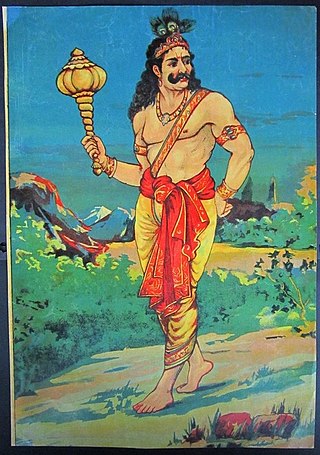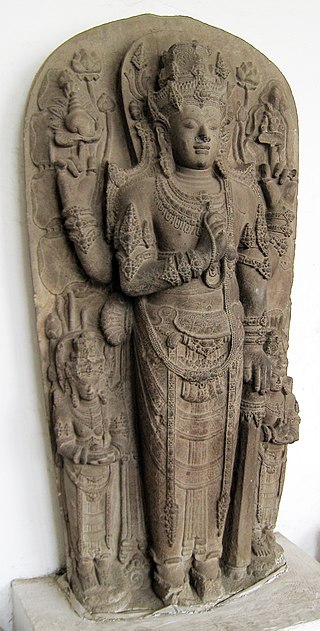
In the Hindu epic Mahabharata, Bhima is the second among the five Pandavas. The Mahabharata relates many events that portray the might of Bhima. Bhima was born when Vayu, the wind god, granted a son to Kunti and Pandu. After the death of Pandu and Madri, Kunti with her sons stayed in Hastinapura. From his childhood, Bhima had a rivalry with his cousins Kauravas, especially Duryodhana. Duryodhana and his maternal uncle, Shakuni, tried to kill Bhima multiple times. One was by poisoning and throwing Bhima into a river. Bhima was rescued by Nāgas and was given a drink which made him very strong and immune to all venom.

Majapahit, also known as Wilwatikta, was a Javanese Hindu-Buddhist thalassocratic empire in Southeast Asia that was based on the island of Java. It existed from 1293 to circa 1527 and reached its peak of glory during the era of Hayam Wuruk, whose reign from 1350 to 1389 was marked by conquests that extended throughout Southeast Asia. His achievement is also credited to his prime minister, Gajah Mada. According to the Nagarakretagama written in 1365, Majapahit was an empire of 98 tributaries, stretching from Sumatra to New Guinea; consisting of present-day Indonesia, Singapore, Malaysia, Brunei, southern Thailand, Timor Leste, southwestern Philippines although the scope of Majapahit sphere of influence is still the subject of debate among historians. The nature of Majapahit's relations and influence upon its overseas vassals and also its status as an empire still provokes discussion.
Gajah Mada, also known as Jirnnodhara, was a powerful military leader and mahapatih of the Javanese empire of Majapahit during the 14th century. He is credited in Old Javanese manuscripts, poems, and inscriptions with bringing the empire to its peak of glory.

Singhasari, also known as Tumapel, was a Javanese Hindu-Buddhist kingdom located in east Java between 1222 and 1292. The kingdom succeeded the Kingdom of Kediri as the dominant kingdom in eastern Java. The kingdom's name is cognate to the Singosari district of Malang Regency, located several kilometres north of Malang City.

Kediri Kingdom was a Hindu-Buddhist Javanese kingdom based in East Java from 1042 until 1222. This kingdom is centered in the ancient city Dahanapura, despite the lack of archaeological remains, the age of Kediri saw much development in classical literature. Mpu Sedah's Kakawin Bharatayuddha, Mpu Panuluh's Gatotkacasraya, and Mpu Dharmaja's Smaradhana blossomed in this era. The kingdom's capital is believed to have been established in the western part of the Brantas River valley, somewhere near modern Kediri city and surrounding Kediri Regency.

Sultan Anyakrakusuma is known as Sultan Agung was the third Sultan of Mataram in Central Java ruling from 1613 to 1645. He was a skilled soldier who conquered neighbouring states and expanded and consolidated his kingdom to its greatest territorial and military power.

The Kingdom of Pajang or Sultanate of Pajang was a short-lived Muslim state in Java. It was established by Hadiwijaya or Jaka Tingkir, Lord of Boyolali, after a civil war and was a successor to Sultanate of Demak. Hadiwijaya claimed to be a descendant of Brawijaya V, the last king of the Majapahit empire, and Trenggana, the sultan of Demak.

Raden Wijaya or Raden Vijaya was a Javanese emperor, and the founder and first monarch of the Majapahit Empire. The history of his founding of Majapahit was written in several records, including Pararaton and Negarakertagama. His rule was marked by the victory against the army and the Mongol navy of Kublai Khan's Yuan dynasty.

Sri Maharajadiraja Sri Kertanegara Wikrama Dharmatunggadewa, Kritanagara, or Sivabuddha, was the last and most important ruler of the Singhasari kingdom of Java, reigning from 1268 to 1292. Under his rule Javanese trade and power developed considerably, reaching the far corners of the Indonesian archipelago.

The Panji tales are a cycle of Javanese stories, centred around the legendary prince of the same name from East Java, Indonesia. Along with the Ramayana and Mahabharata, the tales are the basis of various poems and a genre of wayang known in East Java as wayang gedhog. Panji tales have been the inspiration of Indonesian traditional dances, most notably the topeng (mask) dances of Cirebon and Malang, as well as gambuh dance-drama in Bali. Especially in the environs of Kediri, the suggested homeland of the tales of Panji, local stories grew and were connected with the obscure legendary figure of Totok Kerot. Panji tales have spread from East Java (Indonesia) to be a fertile source for literature and drama throughout Indochina Peninsula and Malay World as well.

The Yuan dynasty under Kublai Khan attempted in 1293 to invade Java, an island in modern Indonesia, with 20,000 to 30,000 soldiers. This was intended as a punitive expedition against Kertanegara of Singhasari, who had refused to pay tribute to the Yuan and maimed one of their emissaries. However, in the intervening years between Kertanegara's refusal and the expedition's arrival on Java, Kertanegara had been killed and Singhasari had been usurped by Kediri. Thus, the Yuan expeditionary force was directed to obtain the submission of its successor state, Kediri, instead. After a fierce campaign, Kediri surrendered, but the Yuan forces were betrayed by their erstwhile ally, Majapahit, under Raden Wijaya. In the end, the invasion ended with Yuan failure and strategic victory for the new state, Majapahit.
Jayakatwang was the king of short-lived second Kingdom of Kediri of Java, after his overthrow of Kertanegara, the last king of Singhasari. He was eventually defeated by Raden Wijaya, Kertanegara's son-in-law using the troops of the Mongol Yuan dynasty that were invading Java. Raden Wijaya would later turn against the Mongols and found Majapahit, a great empire centered around Java.

Kahuripan was an 11th-century Javanese Hindu-Buddhist kingdom with its capital located around the estuarine of Brantas River valley in East Java. The kingdom was short-lived, only spanning the period between 1019 and 1045, and Airlangga was the only raja of the kingdom, which was built out of the rubble of the Kingdom of Mataram after the Srivijaya invasion. Airlangga later in 1045 abdicated in favour of his two sons and divided the kingdom into Janggala and Panjalu (Kadiri). The kingdom's name derived from Old Javanese term hurip with circumfix ka- -an which means "life" or "livelihood". Later in 14th to 15th century, the former kingdom was recognised as one of Majapahit's 12 provinces.
Raden Patah, also known as Jin Bun was the first sultan of the Demak Sultanate. Ascending to the throne in 1475, his remained a vassal of the Majapahit Empire until 1478. Raden Patah took the title Panembahan Jimbun after legitimizing the Sultanate of Demak as the successor state to the Majapahit Empire, with Wali Sanga appointing him as the Sultan of Demak.
The Regreg War was a civil war that took place in 1404–1406 within the Javanese empire of Majapahit. The conflict was fought as a war of independence between the Western court led by Wikramawardhana against the breakaway Eastern court led by Bhre Wirabhumi. This war of rivalry and secession had caused calamity, crisis, court's preoccupation, the drain of financial resources, and exhaustion, which is thought to be one of the causes of Majapahit's decline in the following years.
Singgasana Brama Kumbara is an Indonesian historical-drama television series, produced by PT. Menaragading Citraperkasa. It is an adaptation of a popular radio series called "Saur Sepuh" with some changes in the plot. It was first aired on ANTV on March 4, 1995.
Amangkurat III was a short-lived susuhunan (ruler) of the Sultanate of Mataram, who reigned 1703–1705.
Panembahan Senapati, formally styled Panembahan Senapati ing Ngalaga Sayyidin Panatagama, was the founder of the Mataram Sultanate.
Puput Tono dan drai dal Damu dan dao anak rida Akni danut Danu dan akan danitu Sajeu dae( lngger Wonosobo dan nut danitu anak dant sanitu dari Dani dan mutu dar) dan










